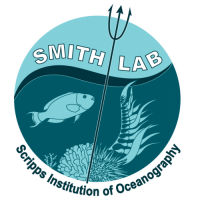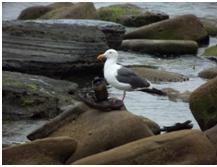Like most kids growing up, I envisioned a scientist as someone sitting behind a microscope or pouring colorful liquids into a flask to make some kind of potion.
During my internship I have seen the variety of work researchers do every day. An average day might include sitting behind a computer doing a literature review, taking water samples in the lab, extracting enzymes from specimens and going to a meeting based entirely on statistical analyses. These tasks have all been incredible learning experiences, but recently I got a taste of my new favorite activity in research: going into the field.
Our first day of collecting crustose coralline algae (CCA) began promptly at 6 am at Sunset Cliffs in San Diego with Emily Dohmon (Masters student from Moss Landing), Susan Kram, Molly Gleason and myself. Since CCA are common in the intertidal pools at Sunset Cliffs, we had to be sure to collect on a low low tide, and it just so happens that this week those low tides were much earlier than would have been preferred. Caffeinated beverages in hand, our small team trekked to the shore and discussed distinctive features of the species we were looking for. Many species of CCA look similar and multiple species can inhabit the same small cobble. We split up and waded through the low tide, searching beds of sea grass and small rock crevices for any stones with a distinctive layer of red algae. After about an hour we had found enough samples to run our experiments and we headed back to the lab to take a closer look at the CCA.
The following day we were out in the brisk morning air of Sunset Cliffs once again, this time searching for an articulated species of coralline algae .We found ourselves, again, searching the warm water of the seagrass beds to collect healthy samples with a delicate touch. As the sun rose over the cliffs we started on our way back to the lab with the treasures of the day to begin our experiment. The samples we collected from Sunset Cliffs are now part of an ongoing ocean acidification experiment in the Smith Lab. Being a part of an experiment from the very beginning and knowing exactly where each of your samples come from makes a project just a little more special and is something you can be a little more proud of when it has run its course.



